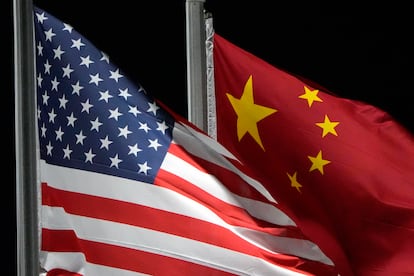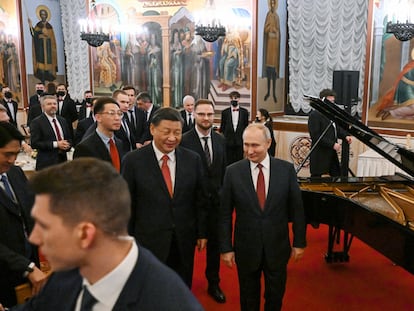China accuses the US of turning Taiwan into a powder keg with its latest sales of military equipment
The U.S. State Department approved of the sale of 30 mm ammunition and related equipment, along with spare parts for Taiwan’s vehicles, small arms, combat weapon systems, and logistical support items

China’s Defense Ministry accused the United States of turning Taiwan into a powder keg on Wednesday with its latest sales of $440 million in military equipment to the self-governing island democracy.
The U.S. State Department approved of the sale of 30 mm ammunition and related equipment, along with spare parts for Taiwan’s vehicles, small arms, combat weapon systems, and logistical support items. Chinese Defense Ministry spokesperson Col. Tan Kefei responded that “the U.S. ignores China’s core concerns, crudely interferes in China’s internal affairs, and deliberately escalates tensions across the Taiwan Strait.”
China claims Taiwan as its own territory, to be conquered by force if necessary, and Tan said “stern representations” had been lodged with the U.S.
“This is tantamount to accelerating the transformation of Taiwan into a ‘powder keg’ and pushing the Taiwanese people into the abyss of disaster,” he said in a statement on the ministry’s website.
Using force to seek independence is wishful thinking and is doomed to failure, he said, using standard Chinese terminology, adding that the People’s Liberation Army was always ready and would maintain peace and stability in the Taiwan Strait.
The U.S. maintains a “One China” policy under which it does not recognize Taiwan’s formal independence and has no formal diplomatic relations with the island in deference to Beijing. Nonetheless, U.S. law requires a credible defense for Taiwan and for the U.S. to treat all threats to the island as matters of ‘’grave concern.”
China regularly sends warships and planes across the center line in the Taiwan Strait that provides a buffer between the sides, as well as into Taiwan’s air defense identification zone, in an effort to intimidate the island’s 23 million people and wear down its military capabilities.
During a transit stop in the U.S. by Taiwanese President Tsai Ing-wen in April, during which she met with U.S. House Speaker Kevin McCarthy, China staged three days of large-scale drills around the island, simulating a blockade. China opposes any exchanges at the official level between Taiwan and other governments.
On Wednesday, 26 PLA aircraft and 4 Chinese navy ships were detected around Taiwan, the Taiwanese Defense Ministry said. Aircraft, navy vessels and land-based missile systems were monitoring the situation, it said.
Few Taiwanese seem fazed by such displays, with the vast majority favoring maintaining the island’s current status of de-facto independence. The island split from mainland China amid civil war in 1949.
In its announcement of the sale, the State Department said it “serves U.S. national, economic, and security interests by supporting the recipient’s continuing efforts to modernize its armed forces and to maintain a credible defensive capability.”
“The proposed sale will help improve the security of the recipient and assist in maintaining political stability, military balance, and economic progress in the region,” it said. The ammunition and associated equipment will maintain the effectiveness of Taiwan’s CM34 Armored Vehicles while “further enhancing interoperability with the United States.”
In addition to purchasing military hardware from the U.S. — with an estimated $19 billion of F-16 fighter jets and other items on backorder — Taiwan has been revitalizing its domestic defense industries, overhauling training and extending compulsory national service for all men from four months to one year.
While China’s vast military dominates Taiwan’s in almost every category, part of the island’s strategy is to hold off Chinese forces long enough for outside help to arrive.
Sign up for our weekly newsletter to get more English-language news coverage from EL PAÍS USA Edition
Tu suscripción se está usando en otro dispositivo
¿Quieres añadir otro usuario a tu suscripción?
Si continúas leyendo en este dispositivo, no se podrá leer en el otro.
FlechaTu suscripción se está usando en otro dispositivo y solo puedes acceder a EL PAÍS desde un dispositivo a la vez.
Si quieres compartir tu cuenta, cambia tu suscripción a la modalidad Premium, así podrás añadir otro usuario. Cada uno accederá con su propia cuenta de email, lo que os permitirá personalizar vuestra experiencia en EL PAÍS.
¿Tienes una suscripción de empresa? Accede aquí para contratar más cuentas.
En el caso de no saber quién está usando tu cuenta, te recomendamos cambiar tu contraseña aquí.
Si decides continuar compartiendo tu cuenta, este mensaje se mostrará en tu dispositivo y en el de la otra persona que está usando tu cuenta de forma indefinida, afectando a tu experiencia de lectura. Puedes consultar aquí los términos y condiciones de la suscripción digital.
More information
Archived In
Últimas noticias
Welcome to the post-religion era: The idea of Christianity as the absolute truth has become obsolete
‘I thought you would like it’: The risky sexual practice popularized by TV shows and TikTok
The digitalization of tourism: ‘They promise experiences and gave us the worst possible one’
Mexican peso defies uncertainty with forecasts of a new period of stability in 2026
Most viewed
- Sinaloa Cartel war is taking its toll on Los Chapitos
- Reinhard Genzel, Nobel laureate in physics: ‘One-minute videos will never give you the truth’
- Oona Chaplin: ‘I told James Cameron that I was living in a treehouse and starting a permaculture project with a friend’
- Why the price of coffee has skyrocketed: from Brazilian plantations to specialty coffee houses
- Silver prices are going crazy: This is what’s fueling the rally









































